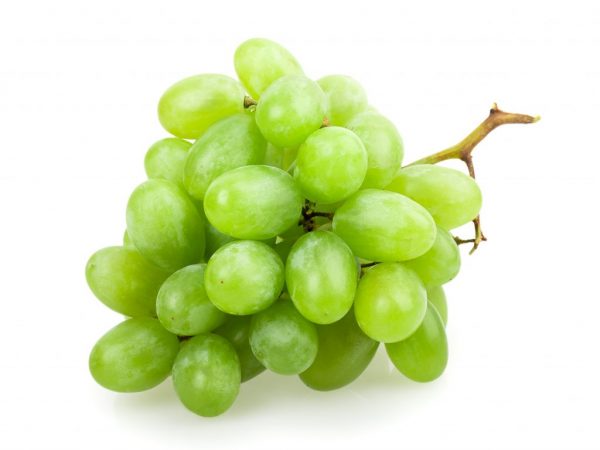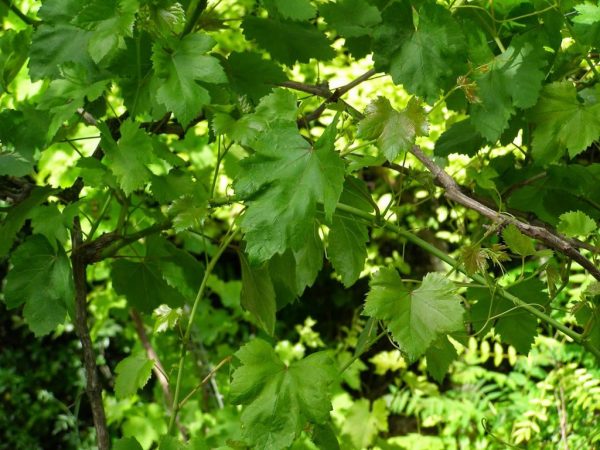Description of grapes Long-awaited
Table grapes The long-awaited appearance is similar to raisins. It is characterized by good yields. Its fruits are large and juicy. The taste is pleasant. The inside of the berries contains a minimum amount of small but hard seeds.

Description of grapes Long-awaited
Features of the variety
According to the description, the grape variety is Long-awaited early. The growing season lasts only 110 days, that is, gardeners begin to harvest from mid-August. Fruiting occurs 3-4 years after planting. The variety is frost and drought resistant.
Description of the bush
The long-awaited table grape is characterized by the rapid growth of the bush - up to 4 m. The flowers are bisexual, so the plant does not need other pollinators.
Grape leaves The long-awaited large size, oval shape. Their color is deep green. A small waxy coating is located on the outer part of the leaf plate; a rough structure prevails. There are a small number of thin stripes on the surface of the sheet, which give it an unusual appearance.
Description of fruits
The berries of the Long-awaited grape variety are characterized by medium size. The shape is oval, the surface is smooth, the color is pale green.
Each bunch is tapered. On the bush, on average, 5-7 pieces appear.
The aroma is pleasant, slightly nutmeg, so this grape variety is often grown for making dessert wine. Children love to feast on fresh berries, as well as eat raisins from them.
Growing
The long-awaited grape variety belongs to thermophilic crops, so it should be grown in sunny areas. The western and southern parts of the garden are ideal for these purposes.
To protect the plant from deformation after planting, a metal support is driven in next to the hole, to which the seedling is tied. The soil must be nutritious (loamy or black soil). Heavy soils are diluted with sand. Humus and peat are introduced into poor lands in advance (20 kg of each preparation per 1 sq. M).
The well is prepared in the fall so that it settles a little and is nourished with useful microelements. Its depth should be 80 cm, width is the same size. The bottom is covered with rubble as drainage. If necessary, pour a bucket of humus and leave in this state until spring.
During planting, the roots are evenly distributed throughout the pit and densely sprinkled with a nutritious layer of soil. Pour 20 liters of water on top. The root collar should be above the ground. The distance between the rows should be 4 m, and between the bushes - 3 m, since the crown is spreading.
Care

Taking care of the plant is easy
Grapes of the Long-awaited variety are easy to care for. It needs standard procedures that include watering, fertilizing, pruning, and weeding.
- Watering the plant begins the next year after planting. Use only warm water so that the roots do not disrupt development. The root water application interval should be 20 days. To do this, a small hole is dug around the bush, into which water is poured. 4-6 days after watering, the top layer of the earth is loosened, removing the crust. Remove all weeds.This helps the roots to get the necessary air and nutrients, and also reduces the risk of pests.
- Top dressing is carried out 2 years after planting. At the first fertilization, we use ammonium nitrate (30 g for each bush). In mid-June, the variety is fed with a solution of potassium nitrate (20 g per 10 l of water) to speed up the process of fruit set. 2 weeks before harvest, make 1 tbsp. l. ammonium nitrate under each bush and thin out the crown.
- Summer pruning involves removing excess shoots and tendrils. Each remaining shoot should have no more than 5 eyes.
Fight against parasites and diseases
According to the description, Long-awaited grapes are characterized by good disease resistance. It is affected only by gray rot and downy mildew. The main signs of gray rot are the presence of gray spots on the leaves, a sharp dryness of the vine and the complete death of the plant. Of the main symptoms of downy mildew, leaf curling and a sharp change in color to yellow are noted.
To get rid of gray rot, solutions of the drugs Karbofos (30 g per 10 l of water) and Regent (20 g per 10 l of water) help. In the fight against downy mildew, a solution of Bordeaux liquid is used (30 g per 10 l of water).
Pests affecting the Long-awaited variety:
- Wasps. Traps using honey or jam can help reduce the risk of their infestation.
- Birds. Special covering materials made of agrofibre or polyester will help to protect the bushes from the invasion of birds.
- Ticks. Copper sulfate (40 g per 10 liters of water) helps fight ticks.
- Flea and aphids. Preparations with a high concentration of copper help to get rid of fleas and aphids. Oxykh is considered the best in this regard (60 g per 10 liters of water).
Treatments should be carried out according to a special plan. The spraying interval should be 10-15 days until the plant is completely cured.
Conclusion
The considered grape variety is considered one of the easiest to grow. She does not need special care, but this does not prevent her from giving a good and tasty harvest. The disadvantage is that the fruits are not resistant to cracking, therefore they are not suitable for long-term transportation.


